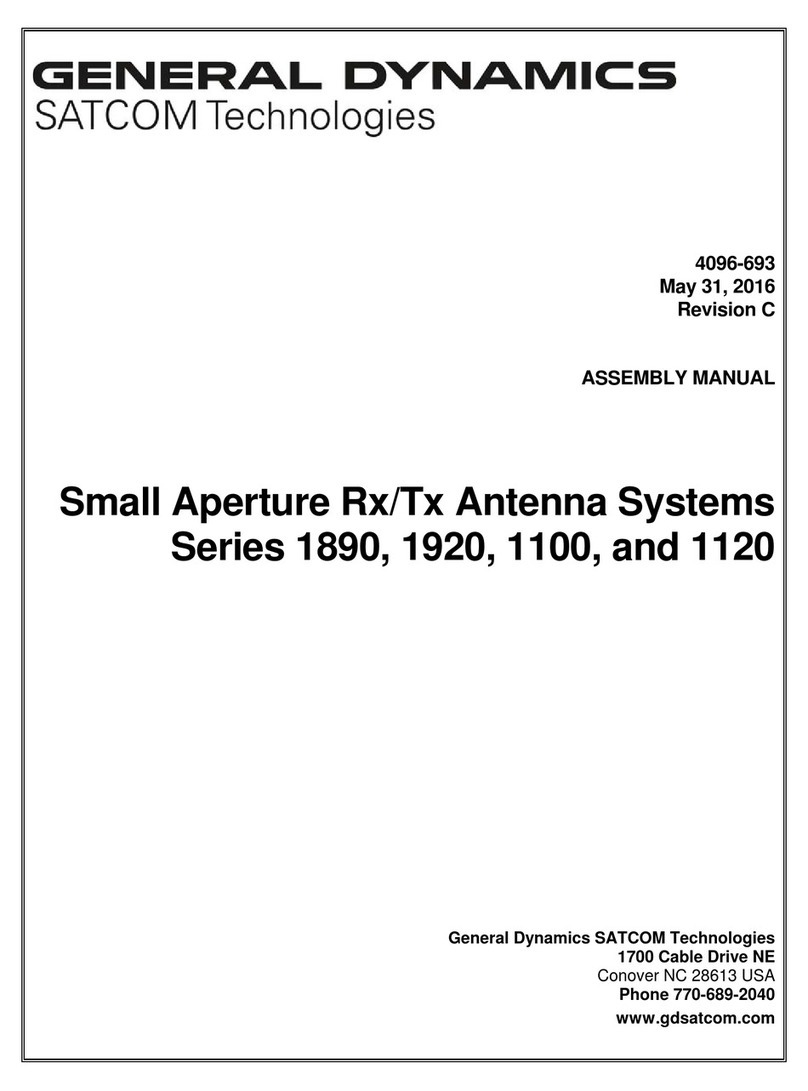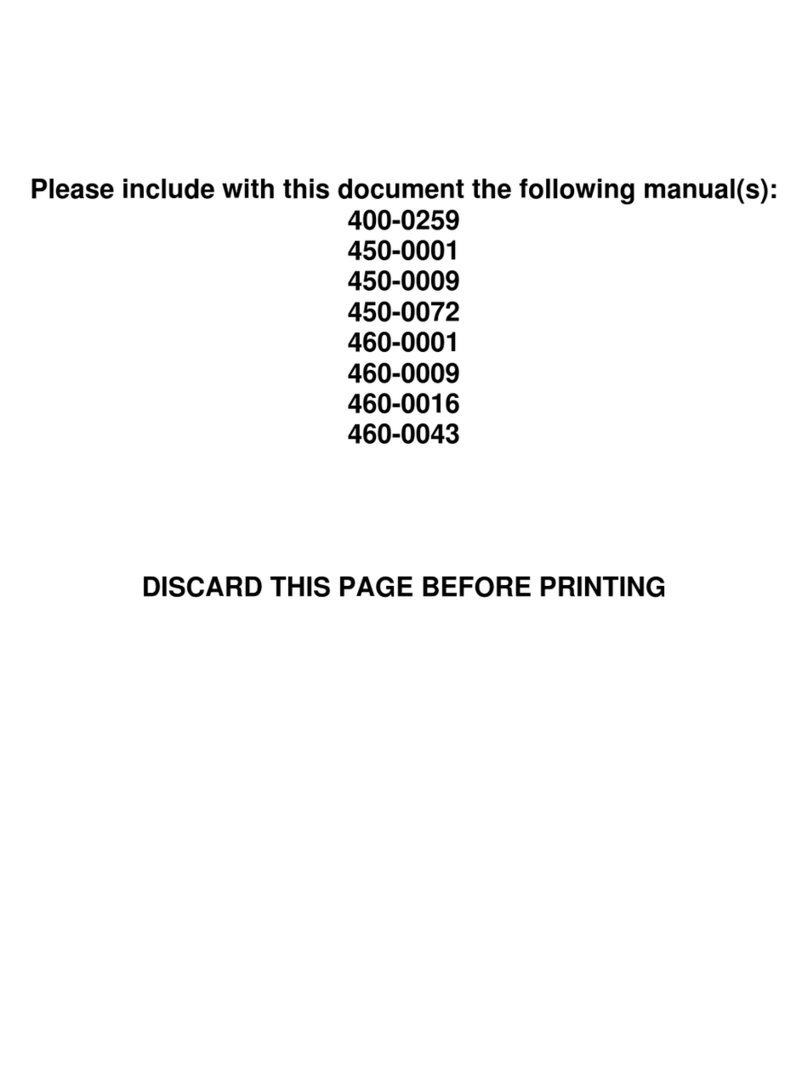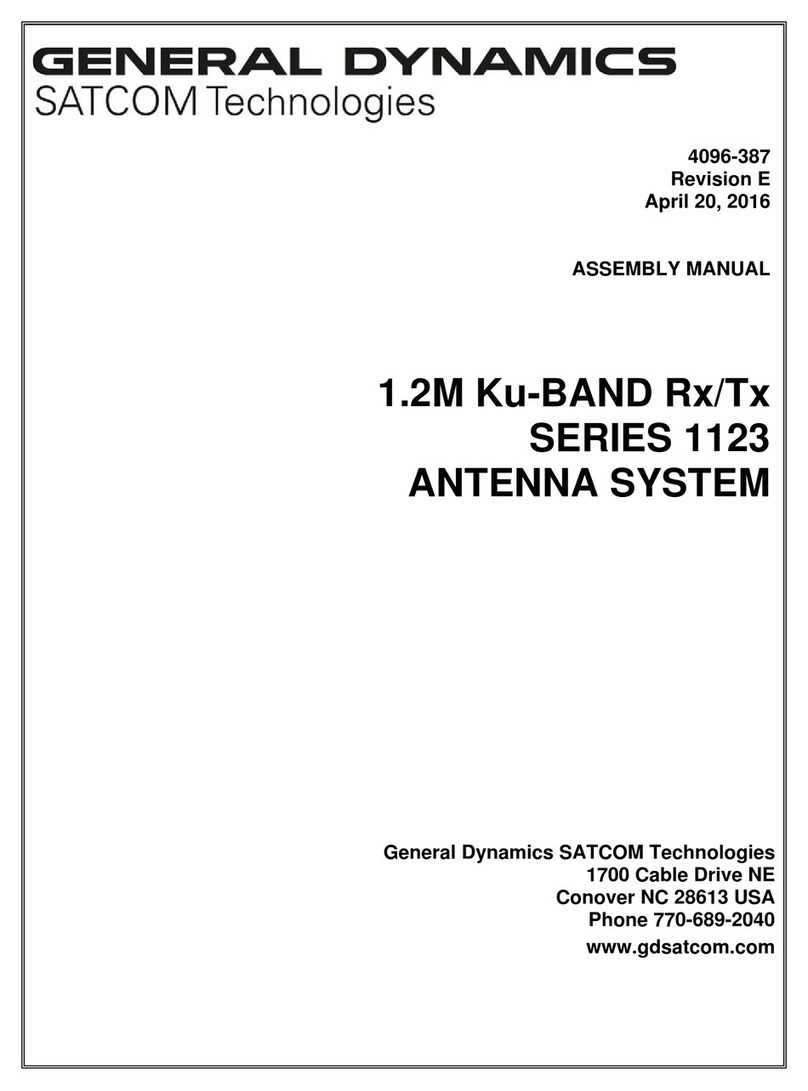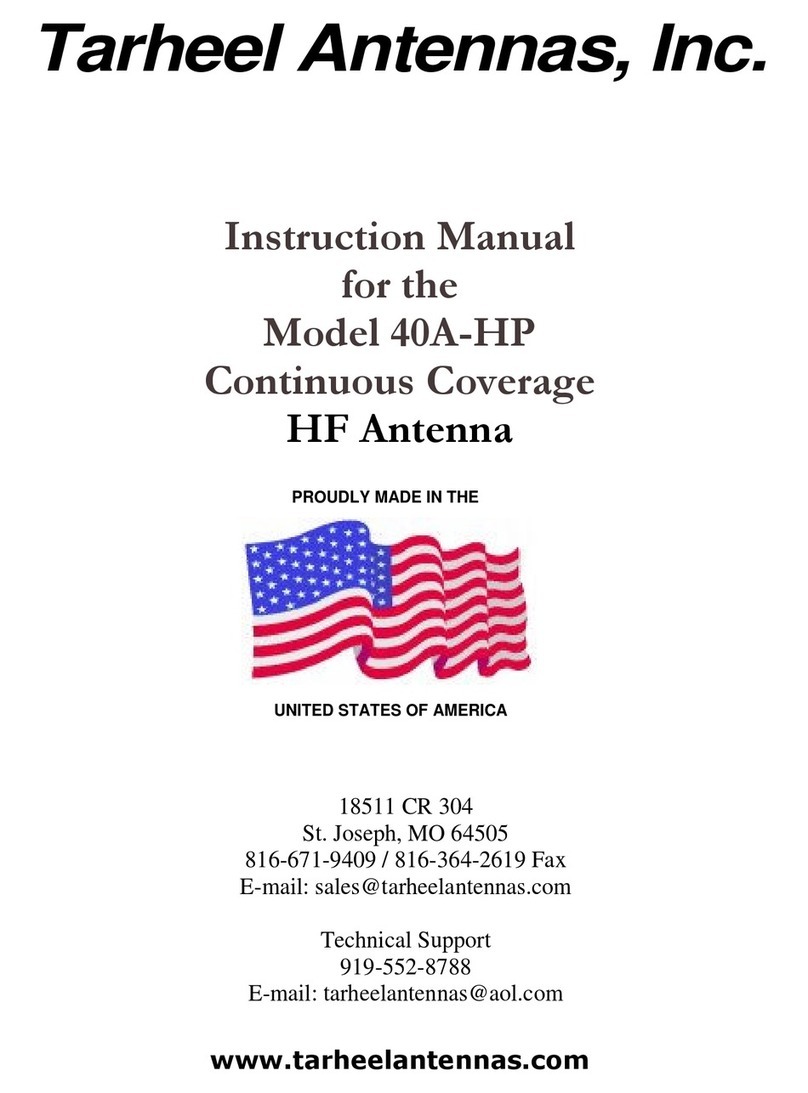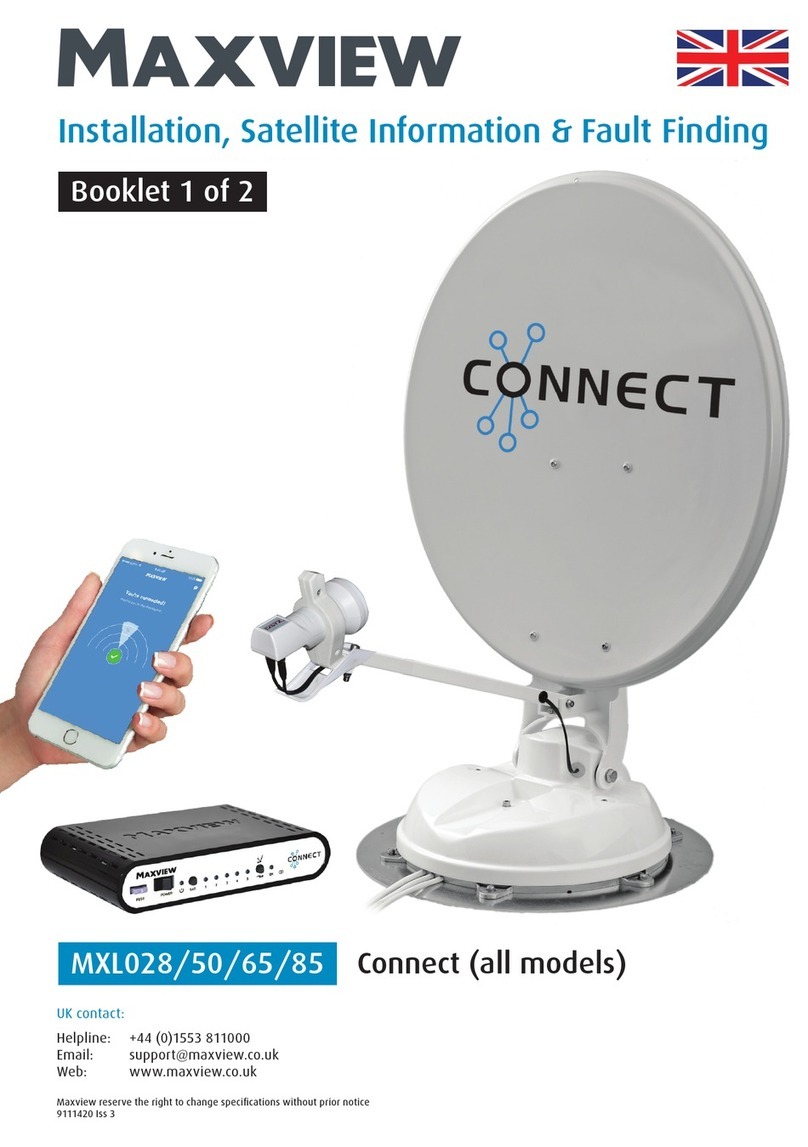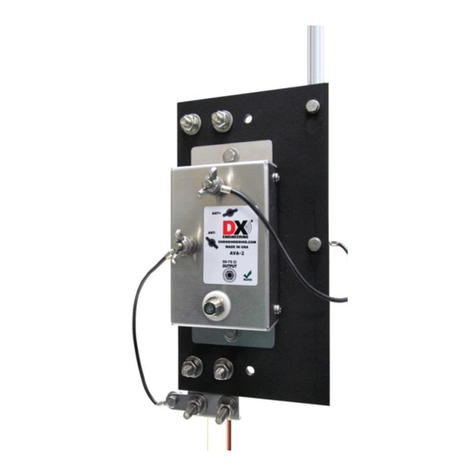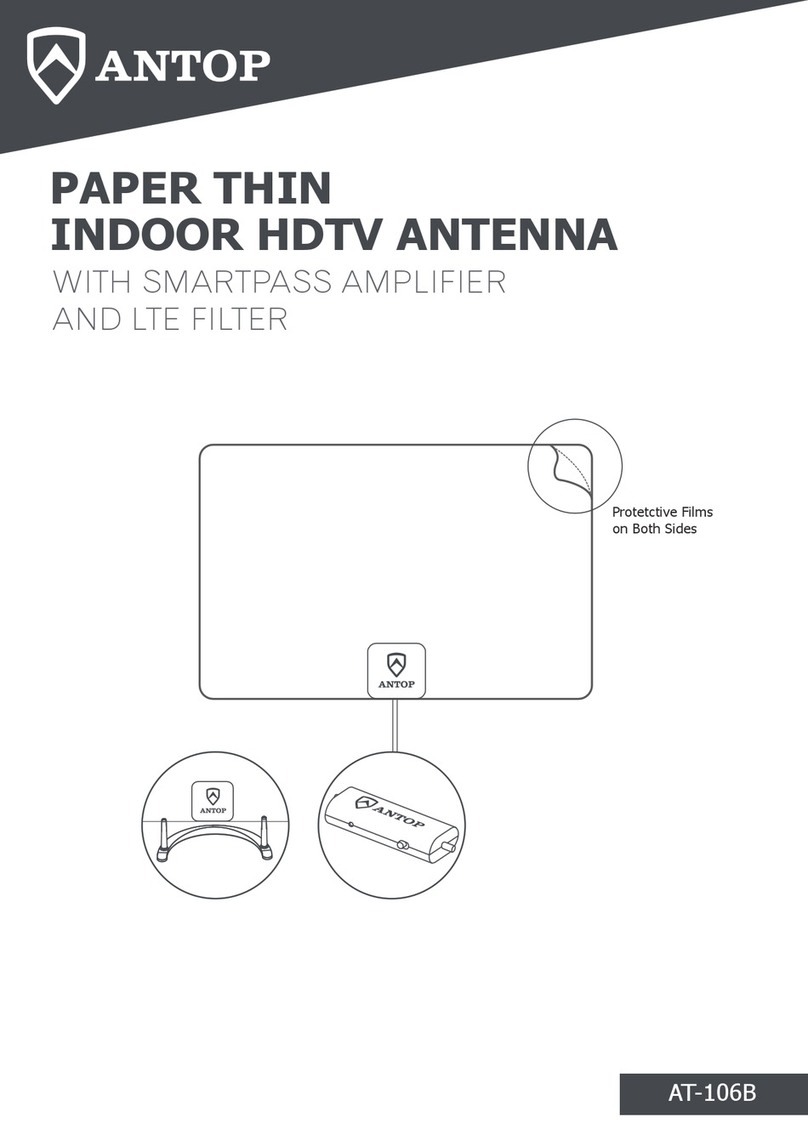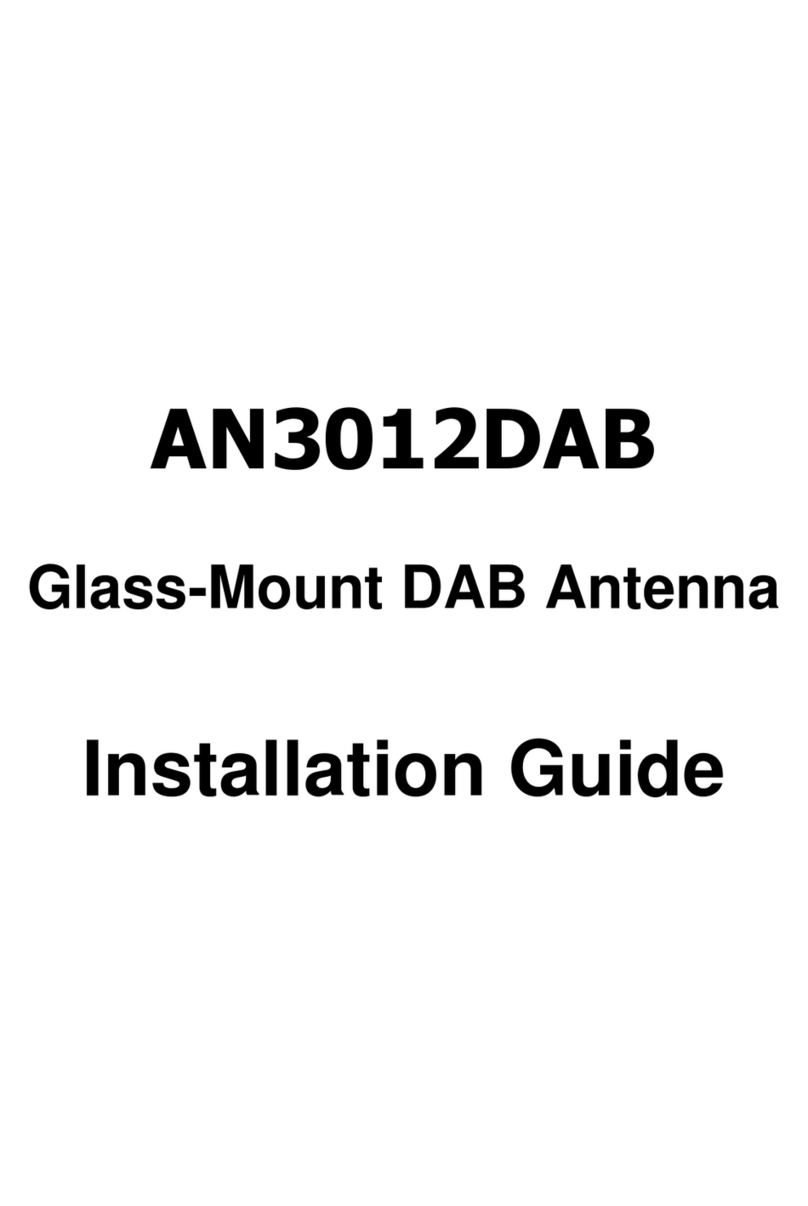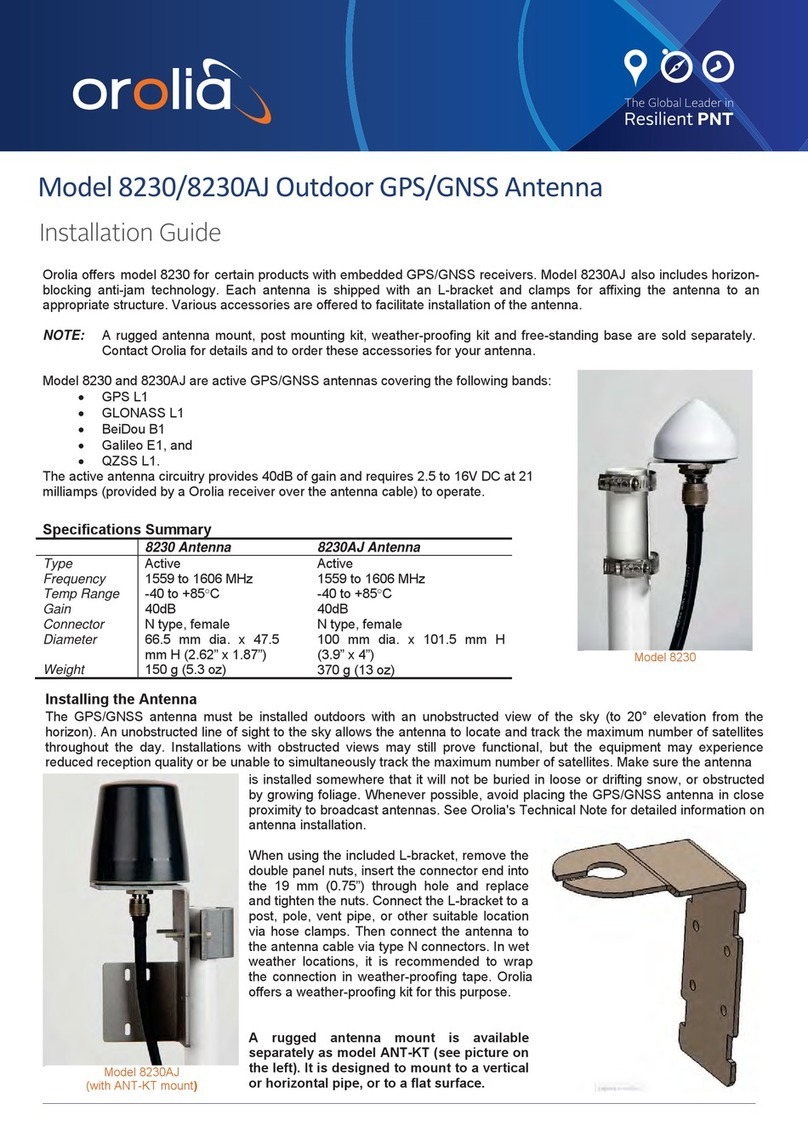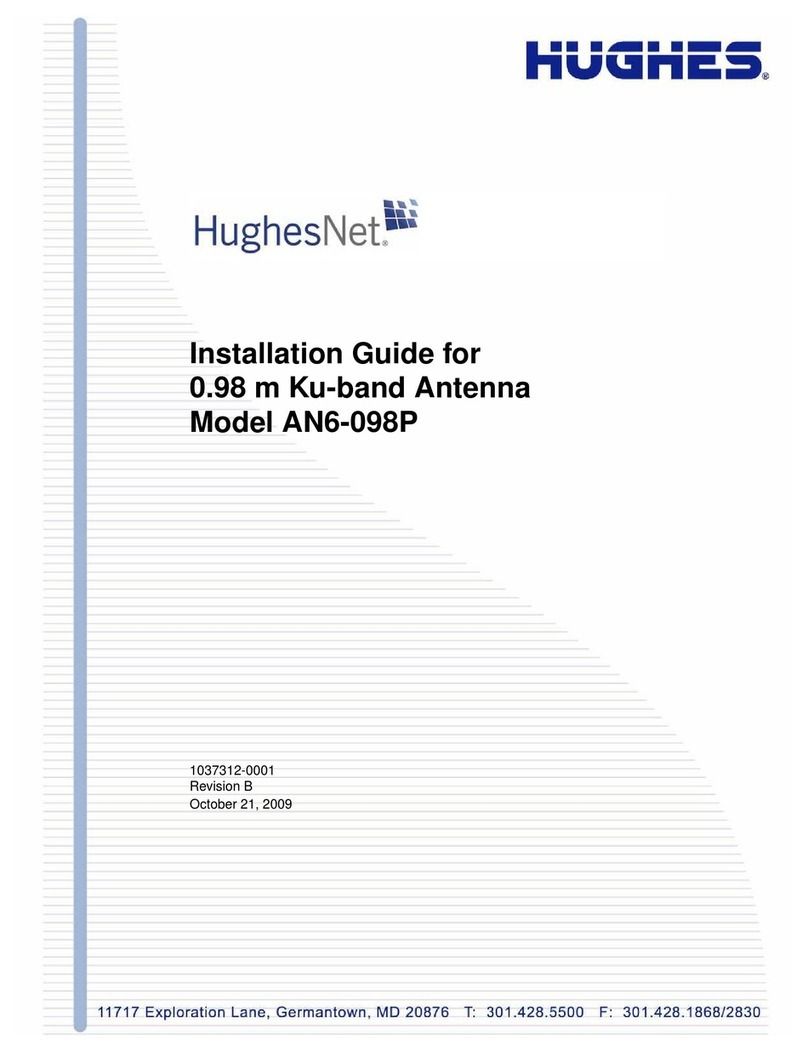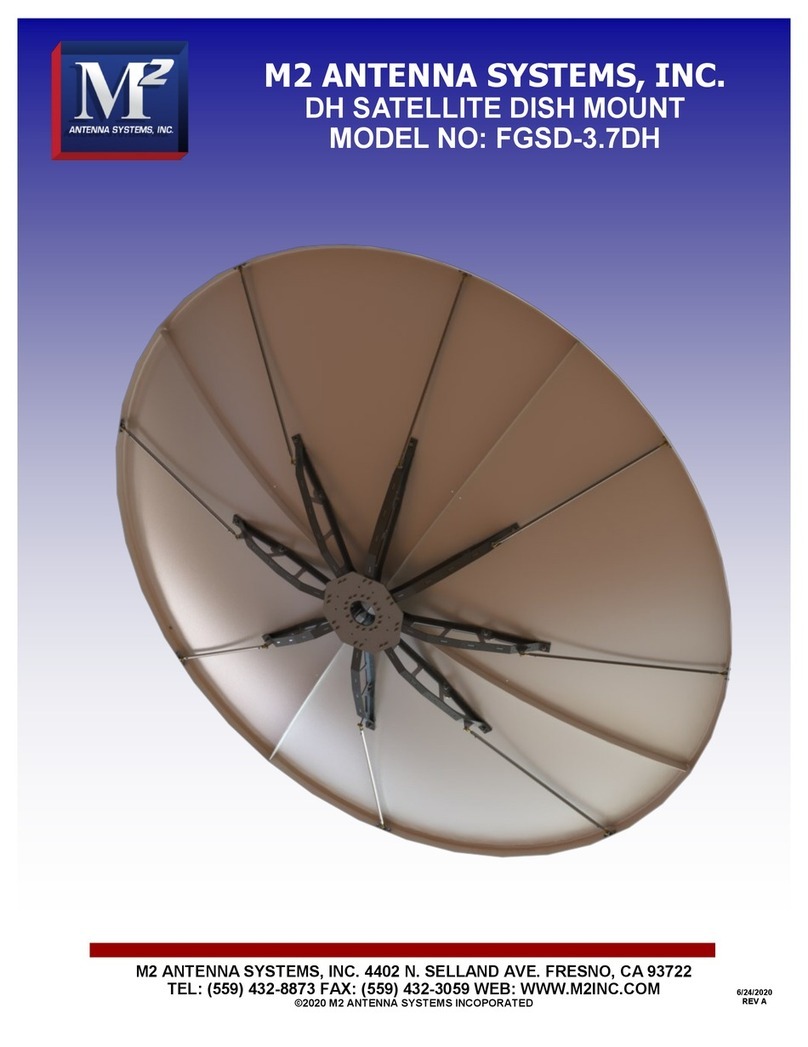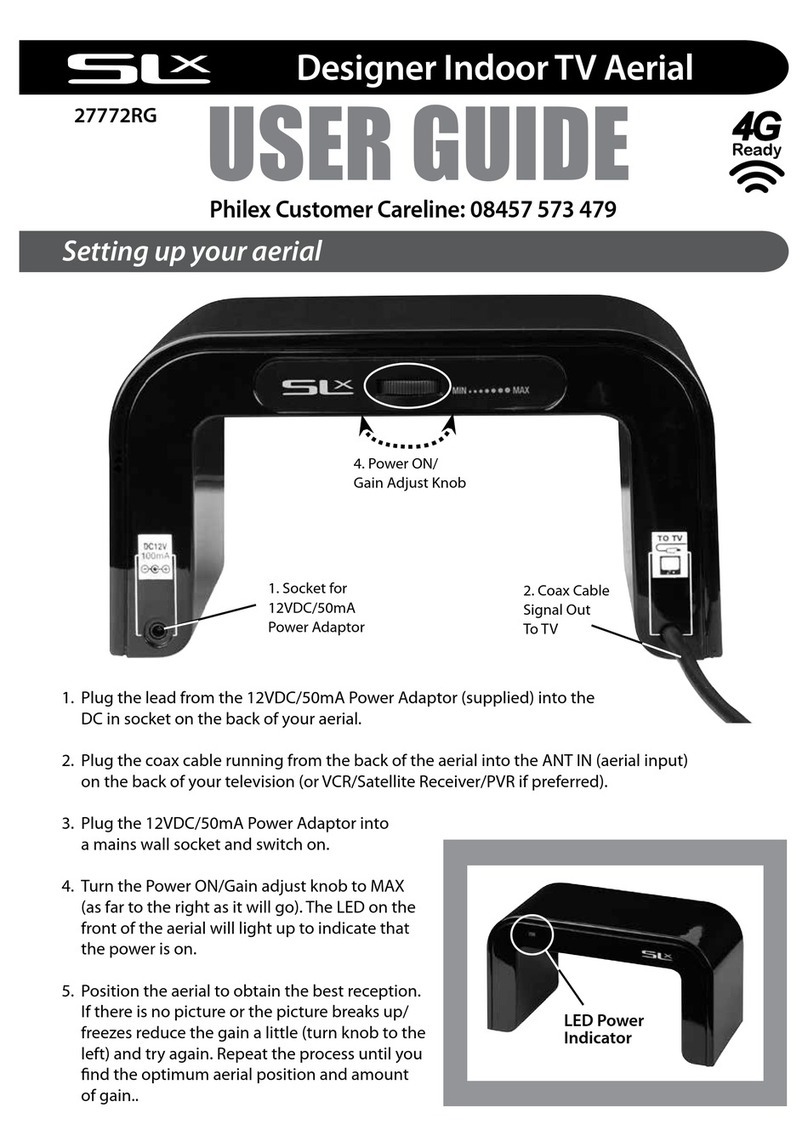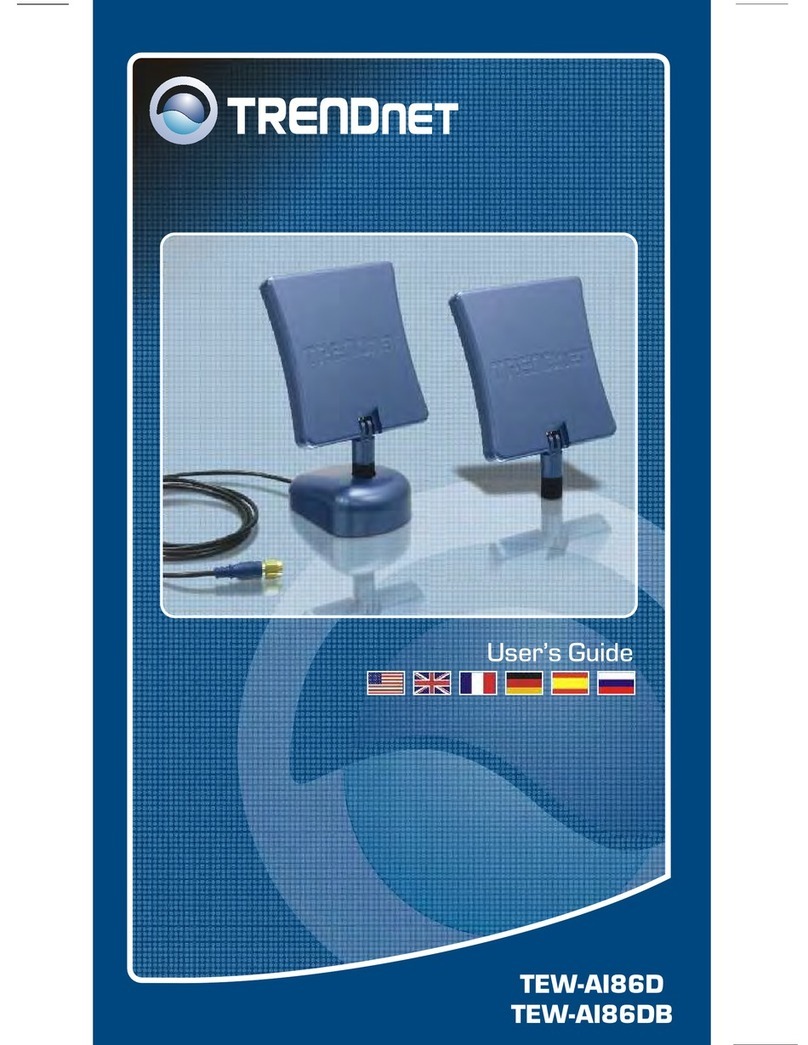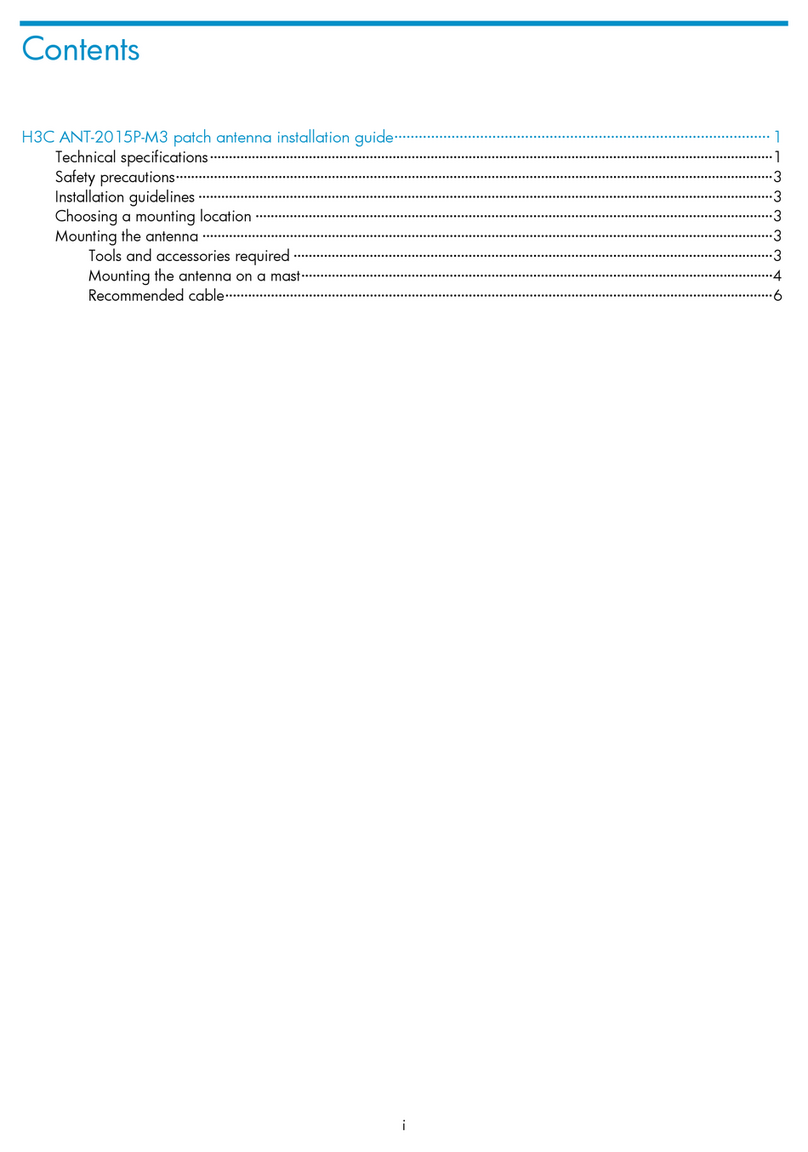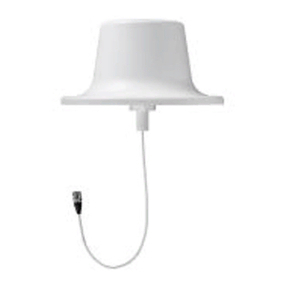General Dynamics 500-0646 User manual

DOCUMENT 500-0646, 3.8M VX Antenna O&M, Installation Manual
Important: In addition to this manual, the following manuals must be provided
to ensure adequate information:
Document No. Description
600-1046 Antenna Feed System Maintenance Manual
PLEASE DISCARD THIS PAGE BEFORE BINDING MANUAL

INSTALLATION, OPERATION, AND MAINTENANCE MANUAL
FOR
MODEL 3.8 METER VX ANTENNA
500-0646
Revision A
July 25, 2006
General Dynamics SATCOM Technologies
2600 N. Longview St., Kilgore, TX USA 75662-6842
Phone (903) 984-0555 yFAX (903) 984-1826
www.gdsatcom.com
"EXPORT CONTROL WARNING - the disclosure of this document or its contents to non-U.S. persons,
or the transmission of its contents outside the United States must be in compliance with U.S. Export Laws
and Regulations. The bearer of this document is under obligation to know the applicable restrictions for
the dissemination of its contents that relate to U.S. Export Laws and Regulations or any other U.S.
government approvals".

500-0646A i
SATCOM TECHNOLOGIES CONFIDENTIAL AND PROPRIETARY
All computer software, technical data or other information pertaining to the equipment covered
by this document is considered proprietary by SATCOM Technologies. Such information
transmitted in this document or related documents is for the benefit of SATCOM Technologies
customers and is not to be disclosed to other parties verbally or in writing without prior written
approval of SATCOM Technologies. Additionally, this document may not be reproduced in
whole or in part without written consent from SATCOM Technologies.
A Original release 7/25/06 JDT LJI SPK
REV. DESCRIPTION DATE WRITER CHK. APPR.

500-0646A ii
Use of WARNINGS, CAUTIONS, etc.
Warnings, Cautions and other notes are included throughout this document to provide
necessary information. IGNORING WARNINGS, CAUTIONS AND OTHER NOTES
MAY RESULT IN DAMAGE TO THE PRODUCT, INJURY, OR IN EXTREME CASES,
DEATH. You should know the use of Warnings, Cautions and other markings.
Definitions are:
WARNING! HIGHLIGHTS AN INSTALLATION, OPERATING OR MAINTENANCE
PROCEDURE, PRACTICE, CONDITION, STATEMENT, ETC., WHICH,
IF NOT STRICTLY OBSERVED, COULD RESULT IN INJURY TO OR
DEATH OF PERSONNEL.
CAUTION! HIGHLIGHTS AN INSTALLATION, OPERATING OR MAINTENANCE
PROCEDURE, PRACTICE, CONDITION, STATEMENT, ETC., WHICH,
IF NOT STRICTLY OBSERVED, COULD RESULT IN DAMAGE TO OR
DESTRUCTION OF EQUIPMENT OR THE LOSS OF MISSION
EFFECTIVENESS OR LONG TERM HEALTH HAZARDS TO
PERSONNEL.
Important: Highlights an essential installation, operating or maintenance
procedure, practice, condition or statement, which, if heeded, will
ensure efficiency and/or safety of said procedures.
Note: Highlights an installation, operating or maintenance procedure, practice,
condition or statement, which, if heeded, could enhance efficiency and/or
safety of said procedures.
ESD: The Electrostatic Sensitive Device (ESD) appears at the beginning of
any procedure or procedural step that includes the handling of
equipment sensitive to damage from electrostatic discharge.
General Warnings and Cautions are also provided at the front of the document. These
Warnings and Cautions should be read by anyone who is involved with installation, has
access to the equipment or is assigned to perform maintenance on the equipment.

500-0646A iii
CAUTIONARY NOTICE
Although SATCOM Technologies has attempted to detail in this document all areas of possible
danger to personnel in connection with the use of this equipment, personnel should use caution
when installing, operating and servicing this equipment. Care should be taken to avoid electrical
shock, whether the hazard is caused by design or malfunction. SATCOM Technologies is
specifically not liable for any damage or injury arising from a technician’s failure to follow the
instructions contained in this document or his failure to exercise due care and caution in the
installation, operation and service of this equipment. SATCOM Technologies shall not be
responsible for injury or damage resulting from improper procedures or from the use of
improperly trained or inexperienced personnel performing such tasks.
This document is intended as a general guide for trained and qualified personnel who are aware
of the dangers of handling potentially hazardous electrical and electronic circuits. This
document is not intended to contain a complete statement of all safety precautions that should
be observed by personnel in using this or other electronic equipment.
ELECTRICAL HAZARDS
The antenna and feed system supplied by SATCOM Technologies is designed to be integrated
with various types of electronic equipment. This system, if integrated with high power amplifiers
or traveling wave tubes, will be capable of transmitting microwave energy at varying power
levels. If transmitting microwave power, SATCOM Technologies cautions the end-user to review
all applicable local, federal and international regulations and to comply with all such regulations
in the operation and maintenance of the integrated system.
The electrical currents and voltages associated with this equipment, whether supplied by
SATCOM Technologies or others, are dangerous. Personnel must at all times observe safety
regulations.
•It is recommended that a lockout/tagout process be utilized while servicing the antenna
system. In the United States, see OSHA 1910.147.
•Always disconnect power before opening covers, doors, enclosures, gates, panels or
shields.
•Always use grounding sticks and short out high voltage points before servicing.
•Do not remove, short-circuit or tamper with interlock switches on access covers, doors,
enclosures, gates, panels or shields.
•Keep away from live circuits.
•Know your equipment and do not take risks.
•Always remove all power to the system prior to working on the antenna, the reflector
assembly, the reflector backup assembly or the feed assembly.
•Always tag all circuits noting that the power is OFF, the date and your name, prior to
commencing any work on that system.
In case of emergency, be sure that power is disconnected.

500-0646A iv
POTENTIAL DAMAGE TO ANTENNA
The antenna limit switches and resolvers have been pre-set to allow for maximum antenna
performance. Any subsequent adjustment may jeopardize antenna performance and/or result in
damage to the antenna.
SAFETY NOTICE
The following safety procedures are listed to remind those performing any work on the antenna
system that safety rules must be observed. Failure to observe safety rules may result in serious
injury or death. Always work safely and in accordance with established procedures.
•It is recommended that a lockout/tagout process be utilized while servicing the antenna
system. In the United States, see OSHA 1910.147.
•Care shall be taken in all operations to safeguard other people as well as property and
to comply with all local safety procedures as established by the customer’s site
representative, as well as local building codes and fire protection standards.
•All persons performing work on the antenna system shall also comply with the
Occupational Safety and Health Act (OSHA) standards and all other federal state and
local laws, ordinances, regulations and codes relating to designated work.
•Unless the customer’s representative on site specifically designates an individual
responsible for site safety, the SATCOM Technologies Site Supervisor shall be
responsible for and establish a site safety program for the SATCOM Technologies
installation work. The site safety program shall incorporate all SATCOM Technologies
safety procedures and requirements
•Never make internal adjustments or perform maintenance or service when alone or
fatigued.
ELECTROMAGNETIC RADIATION
•It is recommended that a lockout/tagout process be utilized while servicing the antenna
system. In the United States, see OSHA 1910.147.
•Do not stand in the direct path of the feed system when the system is transmitting!
•Do not work on the feed system when the system is on!
ALWAYS WORK SAFELY!

500-0646A v
TABLE OF CONTENTS
1.0 INTRODUCTION .............................................................................................................1
1.1 General............................................................................................................................1
2.0 INSTALLATION...............................................................................................................2
2.1 Before Beginning .............................................................................................................2
2.1.1 Antenna Foundation ........................................................................................................2
2.1.2 Shipment Inspection........................................................................................................2
2.1.3 Unpacking Instructions ....................................................................................................2
2.1.4 Tools Recommended for Installation...............................................................................3
2.2 Installation Procedure......................................................................................................5
2.2.1 Pedestal Structure...........................................................................................................6
2.2.2 Azimuth Jack Assembly...................................................................................................7
2.2.3 Hub..................................................................................................................................9
2.2.4 Radial Beam Structure...................................................................................................12
2.2.5 Reflector Lacing Members.............................................................................................16
2.2.6 Reflector Panels ............................................................................................................18
2.2.7 Feed Boom Structure.....................................................................................................20
2.2.8 Subreflector Assembly...................................................................................................23
2.2.9 Feed Boom Alignment...................................................................................................25
2.2.10Feed Horn......................................................................................................................26
2.2.11Overview for Installing Waveguide ................................................................................30
2.2.12Installing the Elevation Limit Switch...............................................................................31
2.2.13Azimuth Limit Switch Installation ...................................................................................32
2.2.14Installing the Elevation Transducer................................................................................32
2.2.15Installing the Azimuth Transducer .................................................................................34
2.2.16Electrical Installation......................................................................................................36
2.2.17Positioning the Antenna on the Satellite........................................................................36
2.2.18Adjustment of Elevation Axis.........................................................................................36
2.2.19Adjustment of Azimuth Axis...........................................................................................36
2.2.20Repositioning the Azimuth Rotating Jack Arm...............................................................36
2.2.21Peaking the Antenna on the Satellite.............................................................................36
3.0 MAINTENANCE ............................................................................................................40
3.1 General..........................................................................................................................40
3.1.1 Antenna Surface Cleaning.............................................................................................40
3.1.2 Electrical Device Cleaning.............................................................................................40
3.1.3 Mechanical Maintenance...............................................................................................40
3.1.4 Pedestal Turning Head And Bearing Plates..................................................................40
3.1.5 Feed Window Inspection ...............................................................................................40
3.1.6 Replacing the Elevation Jack Boot................................................................................41
3.1.7 Replacing the Azimuth Jack Boot..................................................................................41
4.0 WARRANTY..................................................................................................................42
APPENDIX A. HARDWARE CHARTS.....................................................................................A-1
APPENDIX B. SITE SELECTION ............................................................................................B-1
APPENDIX C. REPORTING LOSS OR VISIBLE DAMAGE.................................................... C-1
APPENDIX D. MOUNTING CONSIDERATIONS..................................................................... D-1

500-0646A vi
LIST OF TABLES
Table 1. Tool List .........................................................................................................................3

500-0646A vii
LIST OF FIGURES
Figure 1. Fully Assembled 3.8m VX Antenna..............................................................................5
Figure 2. Pedestal Assembly.......................................................................................................6
Figure 3. Installing the Azimuth Trunnion ....................................................................................7
Figure 4. Installing the Azimuth Jack...........................................................................................8
Figure 5. Installing the Elevation Lugs..........................................................................................9
Figure 6. Installing the Hub........................................................................................................10
Figure 7. Installing the Elevation Jack Support..........................................................................10
Figure 8. Installing the Elevation Jack .......................................................................................11
Figure 9. Antenna Rotated to 90° Elevation...............................................................................12
Figure 10. Radial Alignment Pins...............................................................................................12
Figure 11. Radial Beam Installation...........................................................................................14
Figure 12. Reflector Lacing Assembly.......................................................................................15
Figure 13. Reflector Panel Assembly.........................................................................................17
Figure 14. Reflector Panel Assembly Order ..............................................................................19
Figure 15. Rotating Antenna for Feed Boom Installation...........................................................21
Figure 16. Feed Boom Assembly...............................................................................................22
Figure 17. Feed Boom Assembly Supports...............................................................................24
Figure 18. Subreflector Assembly..............................................................................................25
Figure 19. Feed Boom Alignment..............................................................................................26
Figure 20. Feed Assembly.........................................................................................................28
Figure 21. Feed Alignment.........................................................................................................28
Figure 22. Install Feed Support Kit ............................................................................................29
Figure 23. Install Feed Support Kit ............................................................................................30
Figure 24. Install Feed Support Kit ............................................................................................30
Figure 25. Elevation Limit Switch Installation.............................................................................31
Figure 26. Azimuth Limit Switch Installation ..............................................................................32
Figure 27. Elevation Resolver Assembly...................................................................................33
Figure 28. Elevation Resolver Assembly...................................................................................34
Figure 29. Azimuth Resolver with Bracket.................................................................................35
Figure 30. Azimuth Resolver (side view) ...................................................................................35
Figure 31. Antenna Position.......................................................................................................37
Figure 32. RF Pattern ................................................................................................................38
Figure 33. Feed Port Polarization..............................................................................................39

500-0646A 1
1.0 INTRODUCTION
1.1 General
The 3.8-meter VX antenna is designed to work at various radio frequencies and to be
assembled easily in the field by the user. This dual offset antenna is composed of the
main reflector, subreflector, supporting structures and pedestal structures. After being
properly assembled, this antenna will achieve high gain and exceptional pattern
characteristics.
This manual is designed to guide the user through a logical sequence of procedures
starting with the foundation and continuing on to the pedestal installation. Next, the
optional strut kit (or jack kit) and motor kits are discussed. The reflector is addressed,
followed by the feed and integration kits. Finally, positioning on the satellite is covered to
finalize antenna setup.
This antenna can be fitted with AZ/EL struts or it can be equipped with jacks, screws and
motors. The motorization package can be retrofitted to an existing antenna that has
struts. Throughout this manual, both of these options are referenced. Follow the
appropriate steps for your particular configuration. The antenna can also be retrofitted
with a full line of integration options directly on the feed boom. Options include: transmit
waveguide runs, SSPAs, TWTAs and receive. Also, LNAs, LNBs and block down
converters can be configured.
The 3.8-meter VX antenna is compatible with a full range of control options from jog
control to step track and memory track. Also available for this antenna is a full anti-icing
system for cold weather applications.
It is very important to understand the entire installation procedure to avoid any mistakes
that could result in permanent damage to the antenna. Therefore, SATCOM
Technologies strongly suggests the antenna user 1) read this manual thoroughly before
starting the installation and 2) follow the steps precisely. SATCOM Technologies
disclaims any liability or responsibility for the results of improper or unsafe installation,
operation and maintenance practices. Should any installation, operation or maintenance
questions arise that are not answered within this document, please contact:
General Dynamics SATCOM Technologies
2600 N. Longview St.
Kilgore, Texas USA 75662-6842
Tel: (903) 984-0555
Fax: (903) 984-7597
Note: All personnel installing or working with this equipment should become
thoroughly familiar with the instructions in this manual before starting
work.

500-0646A 2
2.0 INSTALLATION
2.1 Before Beginning
2.1.1 Antenna Foundation
Prior to the installation of the antenna, the antenna foundation must be complete. Refer
to VertexRSI foundation structure drawing 034372 as well as 039304 for conduit, if an
antenna control system such as 7134/7200 will be used. Recommendations for site
selection are presented in Appendix B.
2.1.2 Shipment Inspection
The VertexRSI 3.8-meter VX antenna is packaged in four basic packages with two
optional packages and one customer-dependent package. Once received, the antenna
shipping packages should be inspected for exterior damage. If damage is found, please
contact SATCOM Technologies for correction. See Appendix C for “Reporting Loss or
Visible Damage.”
Prior to the installation process, it is recommended that the components be inventoried
against the parts list for each antenna. A hardware kit is part of the shipment. A Bill of
Material (BOM) is included inside each hardware kit and may be used to inventory the
hardware. Use the Work Order Bill Of Material "Unit Qty" and "Catalogue Number" to
inventory the hardware. Should any part be missing or if damage is apparent, please
refer to Appendix C, "Reporting Loss or Visible Damage." A complete 3.8-meter VX
antenna shipment contains the following:
Package # Description
1 Hub
2 Radial Beams
3 Reflector
4 Motorizable Pedestal (open skid)
5 Hardware Kits
6 Jack or Strut Kit
7 Foundation Installation [optional]
8 Feed Installation [customer dependent]
2.1.3 Unpacking Instructions
Care should be exercised when uncrating and unpacking the equipment. Each package
should be inspected as it is opened. The contents of each package should be checked
against the work-order packing list inside each package or against the parts list to verify
correct part numbers and quantities.
If a claim for shipping damages is to be made, save the packing material, the container
and the accompanying paperwork to substantiate the claim with the carrier. Notify
SATCOM Technologies as soon as possible. Do not return any unit, subassembly or
assembly until authorization and shipping instructions are received from the
factory.

500-0646A 3
2.1.4 Tools Recommended for Installation
This 3.8-meter VX antenna is designed for assembly by a crew of three with the
assistance of a lifting device such as a forklift. The following is only a partial list of
recommended hand tools. Refer to VertexRSI document 500-0321 for a complete listing
of recommended tools for installation.
Table 1. Tool List
Tool Name and Size Quantity
Open End/Box End wrench (each size) 2
5/16", 3/8", 7/16", 1/2”, 9/16", 3/4", 1-1/16"
1/2” Drive Ratchet 15” Long 2
1/2” Drive Extension 10” Long 2
1/2” Drive Extension 6” Long 2
1/2” Drive Sockets (each size) 2
5/16", 3/8", 7/16", 1/2”, 9/16", 3/4", 7/8”, 1-1/16", 1-1/8", 1-1/4"
3/8” Drive Ratchet 15” Long 2
3/8” Drive Extension 6” Long 2
3/8” Drive Extension 10” Long 2
3/8” Drive Sockets (each size) 2
7/16", 1/2”, 9/16"
3/8” Drive (Female) to 1/2” Drive (Male) Adapter 1
Allen Wrench Set (1/16” thru 3/8”) 2
Phillips Screw Driver (+) 2
Regular Flat Screw Driver (-) 2
25 Ft. Measuring Tape 1
Claw Hammer 2
2 lb. Hammer 2
Inclinometer 1
Level (Alum. 18”) 1
Step ladder 6 Ft. (2m) and 16 Ft. (5m) 1
12" Pipe Wrench 1
Cordless drill (must have a clutch) 1
Drill Set (1/16” thru 1/2”) 1
Spade Lug Crimper 2
Caulking Gun 1
Nylon Slings – 2” W x 20’ L 4
Utility Belt 2
Bolt Bag 2
Torque Wrench, 0-250 in–lb (0-30 Nm) 1
Torque Wrench, 90-600 ft-lb (122-814 Nm) 1
Torque Wrench, 10-80 ft–lb (14-109 Nm) 1

500-0646A 4
Awl (1/8" Diameter) 1
Pliers 2
Flat File Machinist (10”) 1
Adjustable Spud Wrench 1
Striking Wrench 1

500-0646A 5
2.2 Installation Procedure
Note: Refer to Figure 1 during installation. This figure is an overall view of the
assembled antenna and can assist the installer with locating parts and
understanding the relationship between the components.
Note: Refer to Appendix A for hardware torque values unless otherwise
indicated within a step.
Figure 1. Fully Assembled 3.8m VX Antenna

500-0646A 6
2.2.1 Pedestal Structure
The pedestal assembly is shipped pre-assembled and is comprised of the V-frame
weldment pinned to the pedestal weldment in two places.
Figure 2. Pedestal Assembly
Step 1. Determine the desired antenna orientation and place the pedestal on the foundation
anchor bolts with the V-frame pointing in the desired direction (foundation hardware is
shipped with the foundation kit). The antenna will typically face south in northern
latitude installations and north in southern latitude installations.
Note: One inch of grout may be used in tracking configurations.
Note: The pedestal assembly should be lifted into place as an assembly using
adequate lifting equipment such as a forklift or hoist.
Step 2. Locate the four 1” x 4” x 4” plate washers and place them on each of the four anchor
bolts. Use a bubble level positioned on the top and sides of the pedestal to ensure
that it is level, both horizontally and vertically.
Step 3. Install one washer and one nut (included in the foundation kit) on each of the four
anchor bolts. Torque the anchor bolt nuts to 740 ft. lbs. ± 10% dry or 560 ft. lbs. ±
10% lubricated.

500-0646A 7
2.2.2 Azimuth Jack Assembly
Step 1. Install the azimuth trunnion to the pedestal. Install one retaining ring on the pin and
slide one flat washer onto the pin. Place the thrust washer above the bottom azimuth
trunnion attachment point and then, while holding the azimuth trunnion in place, insert
the pin from the bottom. Secure the pin by sliding a flat washer onto it and attaching
the second retaining ring. The azimuth trunnion should easily swing right and left at
this point.
Figure 3. Installing the Azimuth Trunnion
Step 2. Attach the azimuth jack to the azimuth trunnion. Slide the azimuth jack tube through
the hole on the azimuth trunnion and secure the jack to the trunnion using 5/8” x 2”
bolts, 5/8” nuts and 5/8” flat washers (four places).
Step 3. Attach the end of the azimuth jack screw to the appropriate lug on the V-frame (see
Figure 4). The appropriate lug is determined depending on the antenna’s azimuth
travel requirements. Use a flat washer and a retaining ring on each end of the pin.
Note: It may be necessary to extend the jack screw to reach the V-frame lug.
This can be accomplished by driving the jack in azimuth using an electric
drill and a 1/2” socket.

500-0646A 8
Figure 4. Installing the Azimuth Jack
Step 4. Install the key on the jack input shaft.
Step 5. Ensure that the motor face sits flush against the flange face.

500-0646A 9
2.2.3 Hub
Step 1. Before installing the elevation lugs, insert the 5/8” x 1-3/4” [15.875mm x 44.45mm]
hot-dip galvanized hardware for feed booms into the first hole in the flat bottom of the
hub (see Figure 5).
Step 2. Install the elevation lugs parallel to the bottom floor of the hub and torque them to 200
ft-lbs [271 Nm].
Figure 5. Installing the Elevation Lugs
Step 3. Mount the hub on the T-head by aligning the holes on the hub brackets with the holes
on the T-head lugs and inserting the pins. Secure the pins with flat washers and
retaining rings.
CAUTION! AS A SAFETY PRECAUTION, THE HUB SHOULD BE HELD IN PLACE
WITH ADEQUATE LIFTING EQUIPMENT (SUCH AS A FORKLIFT OR
HOIST) UNTIL THE ELEVATION JACK SUPPORT AND ELEVATION
JACK ARE INSTALLED.
Feed Boom
Hardware
Elevation Lug
Back
of Hub
Right Side
of Hub

500-0646A 10
Figure 6. Installing the Hub
Step 4. Install the elevation jack support assembly to the bottom of the hub with 3/4" [19.05]
hardware and brackets as shown in Figure 7.
Note: The bolted connection of the jack support assembly should face toward
the front of the hub.
Figure 7. Installing the Elevation Jack Support

500-0646A 11
Step 5. Install the elevation drive assembly to the pedestal base by installing the rod-end pin
and cotter pin.
Step 6. Secure the elevation jack drive assembly to the elevation jack support by installing
the shoulder screws.
Step 7. Install the elevation jack motor following the steps used to install the azimuth jack
motor (see Section 2.2.2).
CAUTION! IF THE MOTOR IS USED ON THE ELEVATION JACK, POSITION IT SO
THAT THE CONDUIT BOX HOLE IS FACING DOWN TO PREVENT
WATER FROM SEEPING INTO THE CONDUIT BOX. THE MOTOR
MAY NEED TO BE ROTATED BACK AND FORTH UNTIL BOTH
COUPLING HALVES LINE UP AND MESH TOGETHER.
Figure 8. Installing the Elevation Jack
Table of contents
Other General Dynamics Antenna manuals
